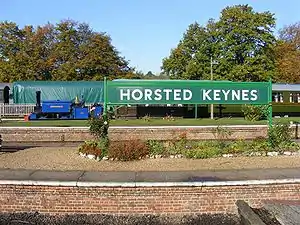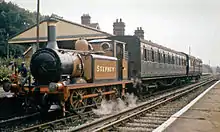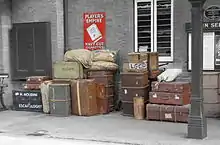Horsted Keynes railway station
Horsted Keynes railway station is a preserved railway station on the Bluebell Railway in Sussex. The station has been used as a shooting location in several film and TV productions.
Horsted Keynes | |
|---|---|
| Station on heritage railway | |
 The station sign and Sharpthorn | |
| Location | Horsted Keynes, Mid Sussex, West Sussex England |
| Coordinates | 51.0461°N 0.0446°W |
| Grid reference | TQ370292 |
| Owned by | Southern Railway Southern Region of British Railways Bluebell Railway |
| Managed by | London, Brighton and South Coast Railway |
| Platforms | 5 (with tracks 1,2,3 and 4/5) |
| Key dates | |
| 1882 | Station opened |
| 7 July 1935 | Electric trains commence via Ardingly |
| 1962 | Commencement of Bluebell Railway services |
| 1963 | Cessation of British Railways services |
History

The station was closed by British Railways under the Beeching Axe on 28 October 1963 with the cessation of trains from Seaford via Haywards Heath (trains over the Lewes to East Grinstead line having ceased in 1958). However, the first Bluebell Railway trains had run on the last day of the 1962 season using the disused eastern side (electrified services only used Platform 2). Between 1960 and 1962 Bluebell Railway services had terminated at Bluebell Halt - a temporary station about half mile to the south.
As a junction station it was the busiest station on the line in terms of services but arguably one of the quieter for passengers. The station lies about 1.5 mi (2.4 km) from the village of Horsted Keynes itself.

Since being taken over by the Bluebell the station has become one of the most popular stations in UK preservation, and has won many awards. It has been restored under a 1930s theme with period newspaper headlines on boards by the buffet and adverts of the period. With five platforms it is the largest preserved heritage railway station in the UK. It is the crossing place for services when two trains are operating and hosts many events each year for steam enthusiasts. It is also the home of the line's Carriage and Wagon department.
The Bluebell Railway plans to eventually make this station a junction once again if plans to extend toward Ardingly are realised, creating something rare within UK preservation, a junction station where both lines are operated by preservationists.
Listed buildings
The main station building, the signal box and an engine house to the south of the station are all Grade II Listed buildings. All three were originally built in or shortly after 1882 to the designs of Thomas Myres, the railway company's staff architect.[1][2][3]
See also
| Preceding station | Following station | |||
|---|---|---|---|---|
| Kingscote | Bluebell Railway | Sheffield Park | ||
| Disused railways | ||||
| West Hoathly Line open, station closed |
London, Brighton and South Coast Railway Lewes and East Grinstead Railway |
Sheffield Park Line and station open | ||
| Ardingly Line and station closed | ||||
 The classic view of the north end of the station, here with 34028 Eddystone.
The classic view of the north end of the station, here with 34028 Eddystone. E4 32473 in the double sided Platforms 4 and 5.
E4 32473 in the double sided Platforms 4 and 5..JPG.webp) The north end after resignalling to allow both lines to the junction beyond the bridge to be used.
The north end after resignalling to allow both lines to the junction beyond the bridge to be used. The south end of the station featuring the signal box on the right with the junction beyond and carriage works on the left.
The south end of the station featuring the signal box on the right with the junction beyond and carriage works on the left.
References
- Historic England. "Horsted Keynes Railway Station (Grade II) (1257915)". National Heritage List for England. Retrieved 9 October 2013.
- Historic England. "Horsted Keynes Signal Box (Grade II) (1257907)". National Heritage List for England. Retrieved 9 October 2013.
- Historic England. "Engine House at Horsted Keynes Railway Station (Grade II) (1257917)". National Heritage List for England. Retrieved 9 October 2013.
External links
| Wikimedia Commons has media related to Horsted Keynes railway station. |
- Horsted Keynes railway station on Trainspot